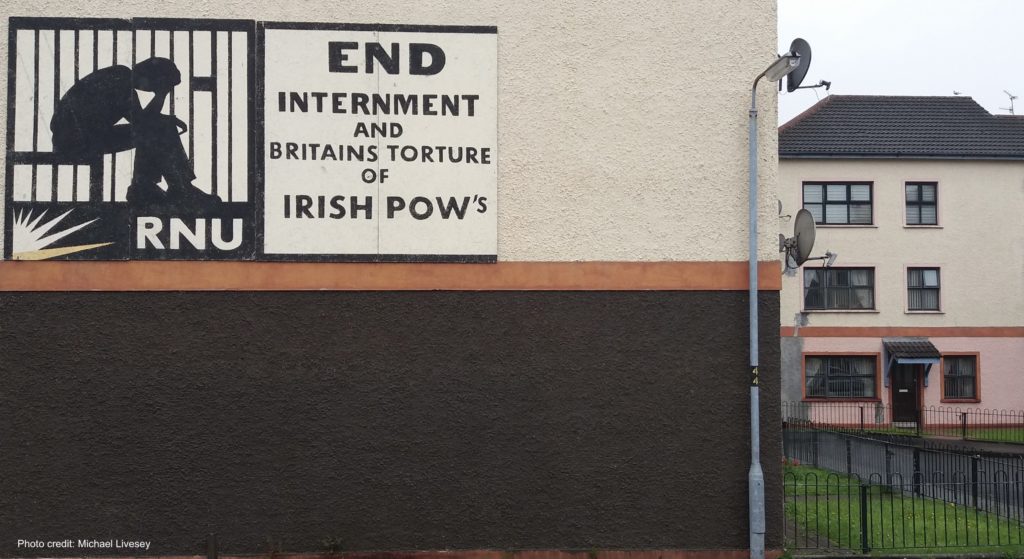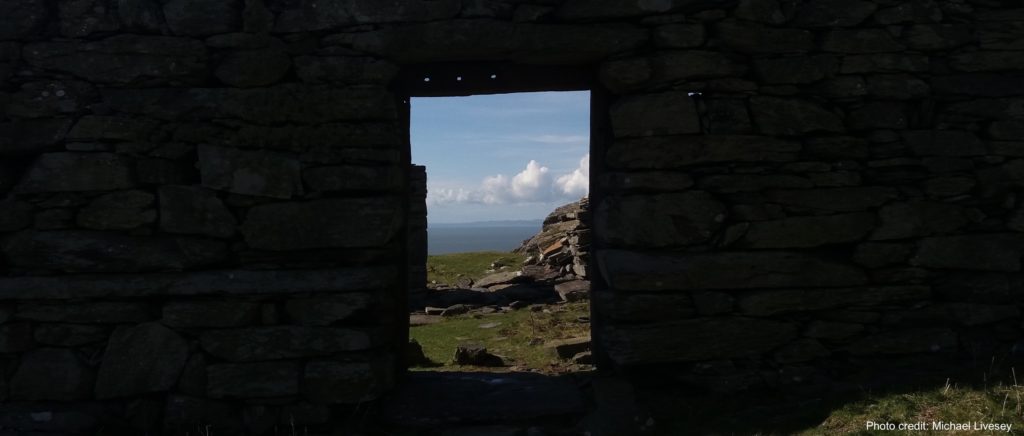
Michael Livesey
‘In order to fully grasp the paths taken by civil wars, we must pay sufficient attention to moments of change in the ways their causes and identities are framed and understood…’
The discursive track
‘How do conflicts turn violent? How do civil wars unfold over time? How do distinct dynamics of civil war affect the post-war potential for peace?’ These questions animate the Civil War Paths project. The project traces those processes which lead into and out of conflict: connecting pre-war, war, and post-war stages via different organisational pathways.
In this post, I want to build on the Civil War Paths framework, by suggesting one of the ‘tracks’ along which these paths might run – both into and out of civil war. Namely, the discursive track.
What do I mean by ‘discursive track’? ‘Discourse’ is a slippery and much-contested term. In my usage, discourse means something like ‘the rules according to which we think (and hence speak) about the world’. These rules help us make sense of what’s going on around us. For example, many people understand conflicts in Iraq or Syria by thinking in terms of the discourse on a Sunni-Shi’a divide. Such discourses serve as conceptual aids: offering both a schema for explaining phenomena, and a script for interacting with them.
But these conceptual aids are not entirely abstract in nature; they don’t exist in isolation from the world they explain. Rather, they are embedded in that world, and play a role in shaping its evolution. For instance, assuming conflicts in Iraq or Syria to be of a fundamentally sectarian quality influences the way participants/observers engage with those conflicts – and places constraints on how they unfold.
In short, when we conceptualise political conflicts, we are also laying ‘tracks’ for their subsequent development. As Michel Foucault put it, these rules for thinking are ‘not situated above history or off to the side’. Instead, they are part of history. And, as such, they must also be part of our analysis of it.
Discursive escalation: criminalisation
An example from my research might clarify this contention. My PhD focuses on a particular discursive track, which unfolded in the context of the Northern Ireland conflict of the 1960s-1990s. Early in that conflict, the British Government adopted a strategy intended to reduce levels of violence, by delegitimising the aims and methods of non-state paramilitaries like the Provisional IRA (PIRA). They called this the ‘Ulsterisation, normalisation, criminalisation’ strategy; and it had several practical manifestations in Northern Ireland. One such was the reinvention of paramilitary inmates’ prison status.

From 1976 onwards, those convicted of offences relating to the ‘Troubles’ were no longer given privileged ‘Special Category’ status (effectively a prisoner-of-war/political prisoner designation). Instead, they were imprisoned as ‘ordinary decent criminals’ – with the implication being that their activities and ambitions were not ‘political’ in nature, but ‘criminal’. This removal of Special Category status communicated the idea that those involved in conflicts over the status of Northern Ireland were not legitimate political agents, but incendiary subversives… ‘Not heroes but criminals; not the pioneers of political change but its direst enemies’, as one Government paper put it.
Collectively, the aggressive policies of ‘Ulsterisation, normalisation, criminalisation’ comprised a framing strategy for the British Government: advancing one way of thinking about the conflict (and those involved in it), with a view to making containment easier. It would be easier, for instance, to police and imprison dissident groups if their activities were known to be ‘criminal’, rather than ‘political’.
But, contrary to the Government’s expectations, this framing strategy actually initiated a period of heightened tension. The removal of Special Category sparked protests amongst prisoners who rejected the ‘criminalisation’ of their identities: culminating in the death of ten republican inmates in the 1981 hunger strike (depicted in Steve McQueen’s 2008 film Hunger). These protests spilled from the prisons onto the streets through a wave of mobilisation. Much of this mobilisation was non-violent. For instance, the massive anti-H-block demonstrations (the H-blocks were the complexes in which hunger strikers were imprisoned); and the rally of over 100,000 people at the funeral of Bobby Sands (the first republican prisoner to die on hunger strike). Other forms of mobilisation, however, were violent – such as the campaign of prison officer shootings. The months of the hunger strike are thought to be some of the tensest, and bloodiest, of the whole conflict.
Discursive peace: the Belfast/Good Friday Agreement
The ‘Ulsterisation, normalisation, criminalisation’ programme thus precipitated an escalation of Troubles violence. It was a discursive track which led to greater tensions between groups within the conflict.
But not all discursive tracks end in strife. Mass gatherings in support of hunger striking prisoners also opened the door to a different track, which would carry the conflict towards peace. Opposition to ‘criminalisation’ expressed in these gatherings alerted republican leaders to gains they could make by entering the electoral field… An instinct on which they capitalised, when Bobby Sands was elected Sinn Féin’s first MP since 1955 (its third in Northern Ireland’s history) in a dramatic by-election shortly before his death. Sands’ election prompted a shift from the ‘long war’ insurgency of the 1970s, to the mixed ‘Armalite and ballot box’ strategy: which saw Sinn Féin emerge as Northern Irish nationalism’s pre-eminent political force.
By the mid-1980s, Sinn Féin was winning seats in Northern Irish, UK, and Irish elections. With mounting evidence of its support amongst nationalist voters, ‘militant’ republicanism could no longer be ignored as criminal or deviant. On the contrary, its leaders now received public invitations to Downing Street to participate in peace talks. A new discursive track was instituted: one in which the PIRA leadership were brought into political dialogue, as equal and necessary partners to peacebuilding. In this way, according to Paddy Logue, Bobby Sands’ election ‘first imagined and then helped to create a credible Sinn Féin and, in doing so, laid the foundations for a peace process’.
What had changed was how the conflict was framed in discourse… From an underground criminal enterprise (the initial British Government frame, rejected by nationalists); to a legitimate political dispute – whose participants’ aims existed on a level of equality with those of Government (the frame advocated by organised republicanism, supported by nationalist voters, and eventually assimilated into Government peace planning).
This returns me to the argument with which I began. The way we think about events is woven into their development. In the Northern Irish case, an aggressive discursive framework precipitated greater conflict; whilst a conciliatory discourse opened the door to peace. This story affords a contribution to theories of escalation/de-escalation in civil war. Namely that, ‘because conceptual change attends any reconstitution of the political world, political change and conceptual change must be understood as one complex and interrelated process’ (per Katy Hayward).
In order to fully grasp the paths taken by civil wars, we must pay sufficient attention to moments of change in the ways their causes and identities are framed and understood.

Things that change, and things that stay the same
But, in addition to this, we must also keep a critical eye out for any conceptual continuities percolating through pre- and post-war stages. We must ask, are any of the pre-war discourses which made conflict possible preserved in post-war settlements?
One of the major discursive underpinnings of the Belfast/Good Friday Agreement is the notion that Northern Ireland is divided between two primordial and immiscible ‘communities’: the nationalist/Catholic community, and the unionist/Protestant community. This communities thesis animates Northern Ireland’s post-peace governance structure: the ‘power-sharing’ arrangement which divides ministries between nationalist and unionist parties. It is also materialised spatially, in the ‘peace walls’ which regulate Northern Irish urban networks: maintaining peace by segregating nationalist and unionist areas.
But this communities thesis, so essential to the peace settlement, is in fact a long-standing contributor to violence on the island of Ireland. It is what Nick Vaughan-Williams calls a ‘frozen regime of thought’: which traps Northern Ireland in a cage of animosity between ostensibly monolithic political tribes.
I started by saying that thinking of conflicts in Iraq/Syria in terms of a Sunni-Shi’a divide affects how those conflicts evolve. The same is true of Northern Ireland. The discourse around the ‘two communities’ is not merely a way of understanding conflict. It is also an open wound: as evidenced by recent violence around the UK/EU Northern Irish protocol. This violence took place (suggestively) at gate points in Belfast’s peace walls. Participants came to peace wall boundaries to express dissatisfaction with the protocol, in terms of the familiar nationalist-unionist zero sum game. The peace walls are a self-fulfilling prophecy. They sustain violent divisions by literally segregating communities in space, and pushing individuals to self-identify according to an old discursive script.
The next challenge for civil war scholarship, then, is to critique enduring discursive architectures, which prolong the possibility of conflict. Too often, these architectures are kept alive in policy-making and ‘expert’ commentary: some of which absorbs discursive assumptions unquestioningly, theorising conflicts according to lazy conceptual categories like the communities thesis. Paying attention to discursive frameworks involves more than explaining civil war processes in the abstract, therefore. It also means guarding against the assimilation of old concepts, which bake violence into the contemporary discursive imagination.

